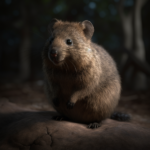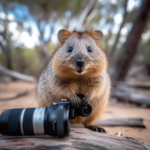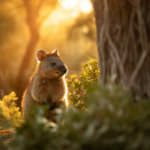The quokka is a small marsupial native to Western Australia. Known for its adorable appearance and friendly demeanor, the quokka has become an internet sensation in recent years. With its smiling face and curious nature, this unique creature has captured the hearts of people around the world. In this article, we will explore the fascinating world of the quokka, including its habitat, behavior, and conservation status. So, let’s dive in and discover more about this delightful animal.
Key Takeaways
- Quokkas are small marsupials found in Western Australia.
- They are known for their friendly and curious nature, often approaching humans.
- Quokkas are herbivores and primarily feed on grasses, leaves, and bark.
- These animals are considered vulnerable due to habitat loss and predation by introduced species.
- Quokkas have become popular tourist attractions, particularly on Rottnest Island, where they are protected.
Understanding the Quokka: Australia’s Native Animal
The quokka is a fascinating creature that calls Australia home. In this section, we will delve into what exactly a quokka is, explore its unique characteristics, and uncover some interesting facts about this adorable Australian mammal.
A. What is a Quokka in Australia?
The quokka, scientifically known as Setonix brachyurus, is a small marsupial that is native to Western Australia. It is often referred to as the “happiest animal on Earth” due to its perpetually cheerful expression. Quokkas are about the size of a domestic cat, with a round face, small ears, and a compact body. They have short, coarse fur that is usually brown or gray in color.
B. Quokka: The Australian Mammal
Quokkas are primarily found in the southwestern part of Western Australia, with their largest population residing on Rottnest Island. This island has become synonymous with quokkas, and visitors from all over the world flock there to catch a glimpse of these adorable creatures. Quokkas are known for their friendly and curious nature, often approaching humans without fear.
One of the most distinctive features of quokkas is their ability to smile. While it may appear as if they are grinning, this is actually due to the unique shape of their mouths. Their mouths have evolved to be short and wide, giving them a perpetual smile-like expression. This endearing feature has made quokkas incredibly popular on social media, with many people eager to capture a selfie with these photogenic marsupials.
C. Australian Quokka Facts: Unveiling the Mystery
Quokkas are primarily herbivores, with their diet consisting mainly of leaves, grasses, and stems. They have a unique digestive system that allows them to extract as much nutrition as possible from the vegetation they consume. This enables them to survive in the harsh and arid conditions of their natural habitat.
Despite their small size, quokkas are excellent swimmers and climbers. They are agile creatures, capable of leaping from tree to tree and navigating through dense vegetation. Quokkas are also known to be primarily nocturnal, which means they are most active during the night. This behavior helps them avoid predators and conserve energy during the scorching daytime temperatures.
In recent years, quokka conservation efforts have been implemented to protect these adorable marsupials. Due to habitat loss and the introduction of predators, such as foxes and cats, the quokka population has faced significant threats. Conservation measures, including the establishment of protected areas and predator control programs, have been put in place to safeguard the future of these unique creatures.
In conclusion, the quokka is a remarkable Australian mammal that captivates the hearts of all who encounter it. With its friendly demeanor, adorable smile, and unique characteristics, the quokka has become an iconic symbol of Australian wildlife. Whether you’re planning a trip to Rottnest Island or simply want to learn more about these fascinating creatures, the quokka is sure to leave a lasting impression.
The Quokka Habitat: Mapping the Australian Terrain
The quokka, a small marsupial native to Australia, is known for its adorable appearance and friendly demeanor. These unique creatures have captured the hearts of many, and if you’re keen to catch a glimpse of them in their natural habitat, you’ll need to know where to look. In this section, we’ll explore the quokka habitat and discover where these fascinating animals can be found across Australia.
A. Do Quokkas Live in Australia?
Yes, quokkas are endemic to Australia, meaning they can only be found in this beautiful country. Specifically, they inhabit the southwestern part of the country, primarily in Western Australia. Their range extends from the mainland to several offshore islands, with Rottnest Island being the most famous quokka hotspot.
B. Quokka Australia Map: Where are Quokkas Found in Australia?
To help you visualize the distribution of quokkas in Australia, here’s a handy map:
| Quokka Distribution in Australia |
|:—:|
|  |
|
As you can see, quokkas are mainly concentrated in Western Australia, with significant populations on Rottnest Island, Bald Island, and Garden Island. They can also be found on the mainland in areas such as Cape Naturaliste, Cape Leeuwin, and the Darling Range.
C. Quokka in Western Australia: A Closer Look
Western Australia is the primary stronghold for quokkas, and it’s where you’ll have the best chance of encountering these adorable creatures. The region’s diverse landscapes, including forests, scrublands, and coastal areas, provide an ideal habitat for quokkas.
One of the most popular destinations for quokka sightings is Rottnest Island, located just off the coast of Perth. This island is often referred to as the “Quokka Paradise” due to its large quokka population and their relaxed behavior around humans. Visitors to Rottnest Island can enjoy cycling or walking around the island, with plenty of opportunities to snap a quokka selfie along the way.
D. Rottnest Island: The Quokka Paradise in Australia
Rottnest Island is a haven for both quokkas and nature enthusiasts alike. With its pristine beaches, crystal-clear waters, and abundant wildlife, it’s no wonder that this island is a popular tourist destination. Quokkas on Rottnest Island have become accustomed to human presence, making it easier for visitors to observe and interact with them.
If you’re planning a visit to Rottnest Island, keep in mind a few guidelines to ensure the well-being of the quokkas. While they may appear friendly, it’s important to remember that they are wild animals and should not be fed or touched. Respecting their space and observing them from a distance is the best way to enjoy their company without causing any harm.
In conclusion, the quokka habitat in Australia is primarily located in Western Australia, with Rottnest Island being a hotspot for quokka sightings. These adorable marsupials have adapted to various landscapes, making them a fascinating part of the Australian fauna. Remember to respect their space and enjoy observing them in their natural habitat, creating unforgettable memories of your encounter with these charming creatures.
Quokka Sightseeing: Where and How
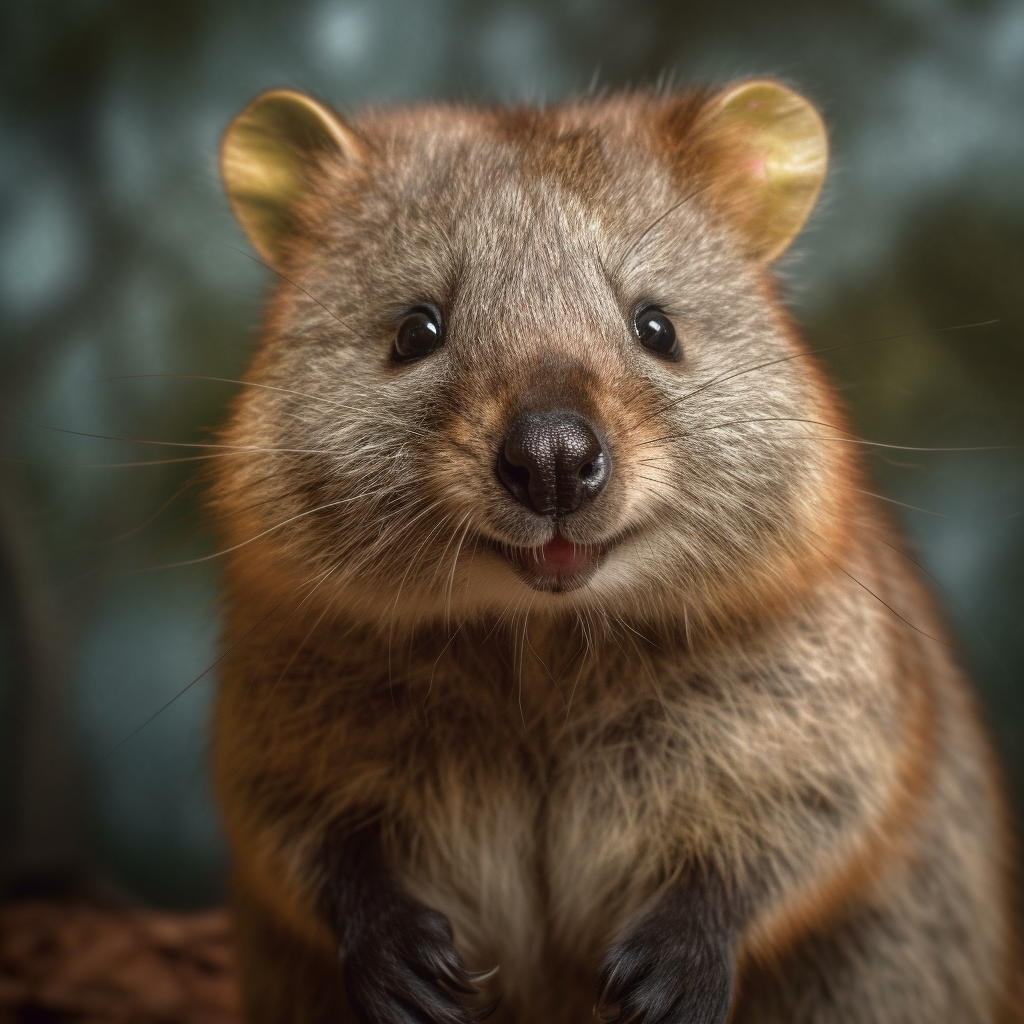
A. Where to See Quokka in Australia: A Comprehensive Guide
If you’re planning a trip to Australia and want to catch a glimpse of the adorable quokkas, you’re in for a treat. These small marsupials are native to Western Australia and are known for their friendly and curious nature. Here’s a comprehensive guide on where to find quokkas in Australia.
1. Rottnest Island
Rottnest Island, located just off the coast of Perth, is undoubtedly the best place to see quokkas in their natural habitat. The island is home to a large population of quokkas, and they can be found all across the island. As a bonus, Rottnest Island is a stunning destination with pristine beaches and crystal-clear waters, making it a perfect spot for a day trip or a longer stay.
2. Other Locations in Western Australia
While Rottnest Island is the most popular spot, quokkas can also be found in other parts of Western Australia. Some of the other locations where you might be lucky enough to spot these adorable creatures include:
- Bald Island Nature Reserve
- Garden Island
- Penguin Island
- Shoalwater Islands Marine Park
These areas provide a unique opportunity to observe quokkas in their natural habitat, away from the hustle and bustle of tourist crowds.
B. The Quokka Experience in Australia Zoo
If you’re unable to visit Western Australia but still want to see quokkas up close, the Australia Zoo is the place to go. Located in Queensland, this world-renowned zoo offers visitors the chance to interact with a variety of Australian wildlife, including quokkas. The zoo provides a safe and controlled environment for visitors to learn about these fascinating creatures and even take selfies with them.
C. Where to Find Quokka in Australia: Tips and Tricks
If you’re keen on finding quokkas in the wild, here are some tips and tricks to increase your chances of a successful encounter:
-
Timing is Key: Quokkas are most active during the early morning and late afternoon, so plan your visit accordingly. They are also more active during cooler months.
-
Be Respectful: Quokkas are wild animals, so it’s important to maintain a respectful distance and observe them from afar. Do not attempt to touch or feed them, as this can disrupt their natural behavior.
-
Look for Food Sources: Quokkas are herbivores and feed on a variety of plants and grasses. Look for areas with abundant vegetation, as this is where they are likely to be found.
-
Stay Patient: Quokkas are known for their curious nature, but they can also be shy. Be prepared to spend some time quietly observing their behavior and movements.
-
Follow Local Guidelines: When visiting quokka habitats, always follow the guidelines set by local authorities and wildlife conservation organizations. These guidelines are in place to protect both the quokkas and their natural environment.
By following these tips and tricks, you’ll have a better chance of spotting these adorable creatures in their natural habitat and creating unforgettable memories.
In conclusion, quokkas are a unique and fascinating part of Australian fauna. Whether you choose to visit Rottnest Island, explore other locations in Western Australia, or experience them up close at the Australia Zoo, seeing quokkas in person is an experience you won’t soon forget. Just remember to respect their natural habitat and follow the guidelines to ensure their continued protection. So, pack your bags, grab your camera, and get ready for an adventure with these adorable marsupials!
The Quokka: An Icon of Australian Wildlife

The quokka, a small marsupial native to Western Australia, has captured the hearts of people around the world. Known for its friendly and photogenic nature, the quokka has become an icon of Australian wildlife. Let’s delve into the world of this adorable creature and discover why it has gained such popularity.
A. Quokka: The Australian Animal
The quokka, scientific name Setonix brachyurus, is a member of the macropod family, which includes kangaroos and wallabies. These small marsupials are found primarily on Rottnest Island, just off the coast of Perth, as well as on some parts of the mainland. Quokkas are known for their distinctive appearance, with a round face, short snout, and small ears.
One of the reasons quokkas have become so beloved is their friendly and curious nature. They are not afraid to approach humans, which has led to the rise of the famous “quokka selfies.” Visitors to Rottnest Island often find themselves face to face with these adorable creatures, making for unforgettable encounters.
B. Quokka: A Peek into the Australian Museum
The quokka’s popularity extends beyond its natural habitat. In recent years, the quokka has become a star attraction in Australian museums and wildlife parks. Visitors can learn more about these fascinating creatures through interactive exhibits and educational programs.
The Australian Museum in Sydney, for example, offers visitors the opportunity to get up close and personal with a quokka. Through guided tours and informative displays, visitors can learn about the quokka’s behavior, diet, and conservation status. These experiences not only educate the public but also promote awareness and appreciation for Australian fauna.
C. Quokka Australian Slang: How it Became a Cultural Phenomenon
In addition to its status as an iconic Australian animal, the quokka has also made its way into Australian slang. The term “quokka” is often used to describe someone who is cheerful, optimistic, and always smiling. This reflects the quokka’s perpetually happy expression, which has endeared it to people worldwide.
The quokka’s positive image has also made it a cultural phenomenon. It has become a symbol of happiness and positivity, with merchandise featuring the quokka’s smiling face becoming increasingly popular. From t-shirts to mugs, people are eager to display their love for this adorable creature.
In conclusion, the quokka is more than just a cute face. It is a symbol of Australian wildlife, a star attraction in museums, and a cultural phenomenon. Its friendly nature and perpetual smile have captured the hearts of people around the world. Whether you encounter a quokka in the wild or through a museum exhibit, one thing is for certain – the quokka will leave you with a lasting impression of joy and wonder.
Quokka Conservation: Challenges and Efforts
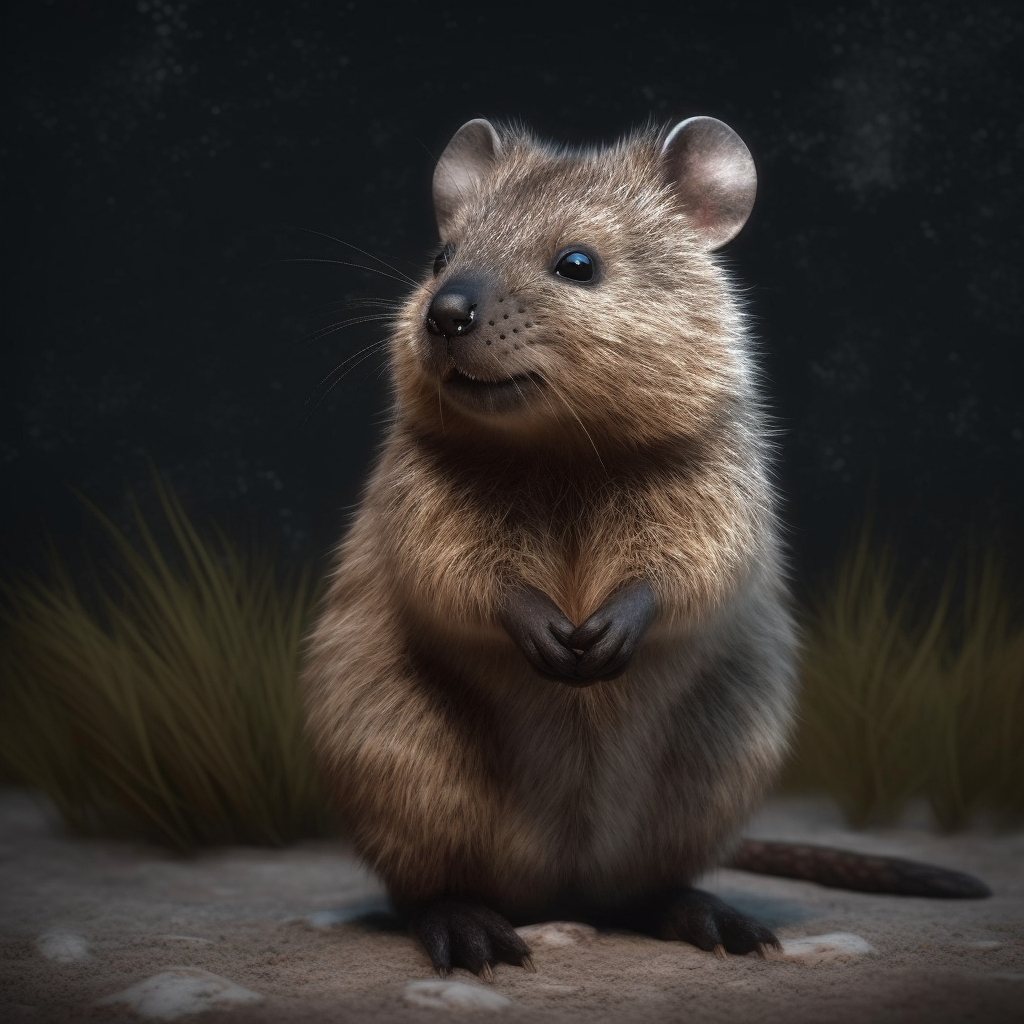
A. Why are Quokkas Endangered: Unraveling the Threats
The adorable quokka, native to Western Australia, is facing several challenges that have led to its endangered status. These threats, both natural and human-induced, have put the quokka population at risk. Understanding these factors is crucial for implementing effective conservation measures.
1. Habitat Loss and Fragmentation
One of the primary threats to quokkas is the loss and fragmentation of their natural habitat. As human populations expand and urban areas encroach upon the quokka’s territory, their living space becomes increasingly limited. Deforestation, land clearing for agriculture, and infrastructure development all contribute to the destruction of the quokka’s habitat.
2. Predation and Competition
Introduced predators pose a significant threat to the quokka population. Predators such as foxes and feral cats, which were brought to Australia by European settlers, prey on quokkas and their young. These predators have had a devastating impact on the quokka population, as the species did not evolve with natural defenses against them.
Additionally, competition for resources with other herbivores, such as rabbits and kangaroos, further exacerbates the challenges faced by quokkas. Limited food availability and increased competition can lead to malnutrition and reduced reproductive success.
3. Climate Change
The effects of climate change, including rising temperatures and altered rainfall patterns, also pose a threat to quokka populations. These changes can impact the availability of food and water sources, disrupt breeding patterns, and increase the risk of wildfires. Quokkas, being highly adapted to their specific habitat, may struggle to cope with these rapid environmental changes.
B. Are There Quokkas in Queensland: A Conservation Perspective
While quokkas are primarily found in Western Australia, there have been no confirmed sightings of wild quokkas in Queensland. The species’ limited distribution is mainly due to their specific habitat requirements and historical factors.
1. Habitat Suitability
Quokkas are highly adapted to the unique environment of Western Australia, particularly the dense shrublands and forests of the region. The availability of suitable vegetation, water sources, and shelter is crucial for their survival. The different climate and vegetation types in Queensland make it less suitable for quokkas compared to their preferred habitat in Western Australia.
2. Historical Factors
Historically, quokkas were more widespread across the Australian continent. However, factors such as land clearing, habitat fragmentation, and the introduction of predators have restricted their range to Western Australia. The absence of quokkas in Queensland is likely a result of these historical factors.
Conservation Efforts
Efforts to conserve the quokka population are underway to mitigate the threats they face and ensure their long-term survival. These conservation initiatives involve various stakeholders, including government agencies, researchers, and local communities.
1. Habitat Protection and Restoration
Protecting and restoring quokka habitat is crucial for their survival. Conservation organizations and government agencies work together to establish protected areas, such as national parks and reserves, where quokkas can thrive undisturbed. Additionally, habitat restoration projects aim to rehabilitate degraded areas and create corridors to connect fragmented habitats.
2. Predator Control
To mitigate the impact of introduced predators, predator control programs are implemented. These programs involve trapping, baiting, and removing predators from quokka habitats. By reducing predator numbers, the survival rates of quokkas and their young can be improved.
3. Public Awareness and Education
Raising public awareness about the importance of quokka conservation is crucial for garnering support and encouraging responsible behavior. Educational campaigns highlight the threats faced by quokkas and promote ethical wildlife interactions. By discouraging activities such as feeding or approaching quokkas for selfies, the well-being of these animals can be safeguarded.
4. Research and Monitoring
Ongoing research and monitoring programs provide valuable insights into quokka behavior, population dynamics, and the effectiveness of conservation measures. This knowledge helps inform management strategies and adapt conservation efforts to ensure their long-term success.
In conclusion, the quokka’s endangered status is a result of various threats, including habitat loss, predation, and climate change. While quokkas are not found in Queensland, conservation efforts in Western Australia are focused on protecting their habitat, controlling predators, raising public awareness, and conducting research. These collective efforts aim to secure the future of this unique and charismatic marsupial.
The Quokka Phenomenon: Uniquely Australian
A. Why Quokka Smile: The Science Behind the Charm
When it comes to adorable animals, the quokka takes the cake. These small marsupials, native to Australia, have captured the hearts of people around the world with their irresistibly cute smiles. But have you ever wondered why quokkas seem to be perpetually grinning? Let’s delve into the science behind their charming smiles.
Quokkas belong to the macropod family, which includes kangaroos and wallabies. Their unique facial structure, specifically their mouth and jaw, gives them the appearance of a smile. However, this “smile” is not a deliberate expression of happiness or joy. It is simply a result of their facial anatomy.
The quokka’s mouth is naturally upturned, with the corners of their lips curving upwards. This, combined with their prominent cheeks and rounded snout, creates the illusion of a smile. Additionally, their large, dark eyes and round ears add to their endearing appearance.
While the quokka’s smile may not be an indicator of their emotional state, it does play a role in their survival. The upturned mouth helps them efficiently chew their diet of grasses, leaves, and other vegetation. It also aids in their communication with other quokkas, allowing them to display submission or aggression through subtle changes in their facial expressions.
B. Quokka: Only Found in Australia
The quokka is a unique and iconic animal found exclusively in Australia. These small marsupials are native to the southwestern part of the country, primarily inhabiting the forests and scrublands of Western Australia. However, their most famous home is Rottnest Island, located just off the coast of Perth.
Rottnest Island is known as the “Home of the Quokka” and is a popular tourist destination for those eager to catch a glimpse of these adorable creatures in their natural habitat. The island‘s protected status ensures the preservation of the quokka population and provides a safe haven for them to thrive.
Outside of Rottnest Island, quokkas can also be found on the mainland, particularly in the forests of Western Australia. However, their numbers are more limited in these areas, making Rottnest Island the best place to encounter them.
C. Australian Quokka Pronunciation: Saying it Right
Now that we’ve covered the quokka’s endearing smile and its exclusive presence in Australia, let’s tackle another important aspect: pronouncing their name correctly. The word “quokka” is derived from the Nyungar language, spoken by the indigenous people of southwestern Australia.
To pronounce “quokka” correctly, follow these simple steps:
- Start with the “kw” sound, similar to the “qu” in “quick.”
- Follow it with a short “o” sound, like the “o” in “hot.”
- Finish with a “ka” sound, similar to the “ka” in “car.”
Put it all together, and you have “kwah-kuh.” Practice saying it a few times, and you’ll be able to confidently refer to these delightful creatures by their proper name.
In conclusion, the quokka phenomenon is truly unique to Australia. Their charming smiles, exclusive habitat, and distinct pronunciation make them a beloved symbol of Australian wildlife. Whether you’re planning a visit to Rottnest Island or simply admiring them from afar, the quokka is sure to bring a smile to your face. Conclusion
In conclusion, the quokka is a unique and fascinating creature that is native to Australia. With its friendly and curious nature, it has captured the hearts of both locals and tourists alike. Despite facing challenges such as habitat loss and predation, conservation efforts are being made to protect and preserve the quokka population. The quokka’s iconic smile and photogenic nature have also made it a popular subject for selfies and social media posts. As a symbol of happiness and resilience, the quokka serves as a reminder of the incredible biodiversity found in Australia. So, if you ever find yourself Down Under, be sure to keep an eye out for these adorable marsupials and maybe even snap a quokka selfie of your own!
Frequently Asked Questions
Q1: Do quokkas live in Australia?
Yes, quokkas are native to Australia. They are predominantly found on Rottnest Island and in smaller numbers in parts of Western Australia.
Q2: What is a quokka in Australia?
A quokka is a small marsupial that is native to Australia. They are known for their friendly nature and distinctive ‘smile‘. They are part of the Australian wildlife and are particularly prevalent on Rottnest Island.
Q3: Where are quokkas found in Australia?
Quokkas are primarily found on Rottnest Island in Western Australia. They can also be found in smaller populations in other parts of Western Australia, including some mainland areas and Bald Island.
Q4: Are there quokkas in Queensland?
No, quokkas are not native to Queensland. They are primarily found in Western Australia, particularly on Rottnest Island.
Q5: What does ‘quokka’ mean in Australian slang?
In Australian slang, ‘quokka’ doesn’t have a specific meaning. It is the name of a small marsupial native to Australia, known for its friendly nature.
Q6: Why do quokkas smile?
Quokkas are often referred to as the ‘happiest animal in the world’ due to their distinctive ‘smile‘. This is actually a result of the shape of their mouth and doesn’t necessarily indicate their emotional state.
Q7: Why are quokkas endangered?
Quokkas are considered vulnerable due to a range of threats including habitat loss, predation by introduced species like foxes and cats, and climate change. Conservation measures are in place to protect these unique marsupials.
Q8: Where can I see a quokka in Australia?
The best place to see a quokka is on Rottnest Island in Western Australia. They are quite friendly and used to human interaction, making it a popular destination for ‘quokka selfies’.
Q9: What is the habitat of a quokka?
Quokkas live in a variety of habitats including forests, shrublands and semi-arid regions. They are particularly adapted to live in the harsh conditions of Rottnest Island.
Q10: What is the diet of a quokka?
Quokkas are herbivores and their diet mainly consists of grasses, leaves, and bark. They can also eat some types of fruits and vegetables.

